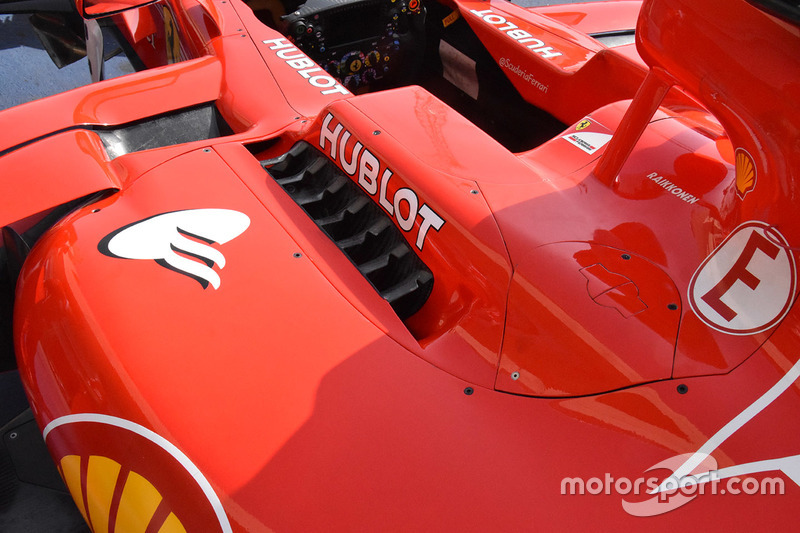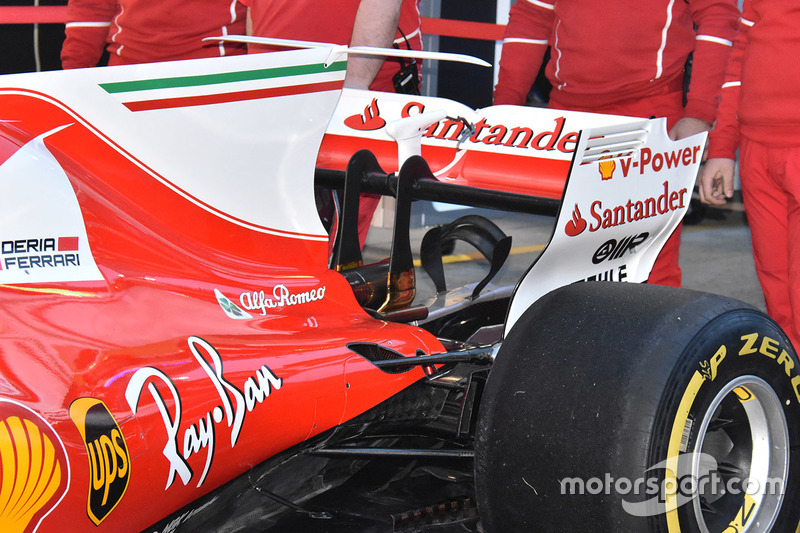Ferrari brings major upgrade to Bahrain GP
Ferrari has introduced a major new update to its SF70H challenger for the Bahrain Grand Prix, in a bid to keep up the pressure on rivals Mercedes.

Photo by: Giorgio Piola
Giorgio Piola's F1 technical analysis
Giorgio Piola is the preeminent Formula 1 technical journalist. View our full selection of Giorgio's technical illustrative content
And with a lack of development having been a weakness of the team in the past, how these new developments work should give us a clear indication on whether or not Ferrari can maintain a title charge.
One of the biggest differences has come with the front wing where, although the philosophy is the same, several changes have been made.
The mainplane is now divided into three sections, with two full length slots traversing it, the forwardmost of which is arrowed (blue). The outer section of the wing has been entirely revised, with the arc shape (white arrow) revised in shape and pushed further from the endplate.
Mirroring these changes are further adaptations to the upper, outer sections of the wing (left unpainted) and arrowed (yellow) with a much more distinct squared tunnel shape appearing, much like the one we’ve seen Mercedes use for some time now.
All of these changes point toward a more concerted effort to shape the airflow passing across and around the front face of the tyre.
It’s also worth noting that the chord length and shape of the inner part of the flaps (painted in white) have been amended too, changing the level of downforce being generated and the shape of the Y250 vortex being shed by the mainplane and controlled by the flap tips.
Furthermore, the flap adjuster (black arrow) has been moved slightly inboard too, making way for the more pronounced arch.
Cooling Louvres
Cooling is of huge priority to the teams, as too much of it means you’re giving up drag for no real benefit, too little and it can have a debilitating effect on the power unit.
The increased temperatures in Bahrain have forced Ferrari to at least look at some more expansive cooling options, with these longer cooling panels fitted for scrutineering.
You’ll note that the designers are not satisfied with a simple louvre though, as the V cutouts in each surface are a deliberate attempt at changing how the hot air is evacuated and mixes with the air that flows over the sidepod.
Floor
It seems that Ferrari alone has thus far taken advantage of the freedom afforded to the teams with the new regulations ahead of the sidepods, with its triangular splitter extensions featuring a hole in the surface, allowing air taken in underneath them to filter into the flow that passes around the front face of the sidepod undercut.
This fully enclosed hole is permissible because it lies ahead of a point 450mm forward of the rear face of the cockpit template, unlike other areas of the floor.
Another area of intrigue since pre-season testing has been Ferrari’s use of the floor for a secondary function.
The first iteration was simply a conduit embedded into the floor which aroused more suspicion when it was seen with thermal stickers placed on it, leading to questions about what was housed within (above, inset).
It’s understood that the conduit houses pipework that transports oil to the gearbox, in order to compartmentalise the cooling from what is going on under the skin of the car.
In China, the team took this one step further, creating a lip on the upper surface of the floor shaped like a butterfly's wing (arrowed).
Not only is this shaped in order to improve the aerodynamic efficiency of that part of the floor but it adds some much needed rigidity after rumours of Ferrari running some kind of flexi-floor arrangement emerged thanks to footage that appeared on social media of the floor fluttering under load.
This flutter, primarily in the section just behind the front wheel, is a section of the floor that has a very specific shape, punctuated by a slot (white arrows), with metal inserted into the floor (red arrow) to add some rigidity and perhaps even a certain level of preload. The slot’s not new and has been on the car since pre-season testing, although the shape has been slightly revised to suit the team's demands.
It is suggested the flutter creates an airflow barrier that disrupts the turbulence that would ordinarily disturb the natural downforce being generated by the floor and diffuser.
Ferrari is not the only team to use holes or slots in this area of the floor for 2017 either, with Mercedes, Toro Rosso, Haas and McLaren sporting holes.
They have all taken advantage of the change in the regulations now allowing a hole, whereas Ferrari has deliberately slotted the floor in order that it has a very different aerodynamic effect to the others.
Rear wing pillars
As well as paddock gossip surrounding Ferrari’s floor, there have also been whispers about Ferrari's’ rear wing rotating at speed – to help reduce drag on the straights.
This story first emerged at the Spanish GP last season, when a rearward facing onboard camera seemed to show the rear wing rotate as speed built, an assertion that seems to have returned, even though the Scuderia has passed all of the relevant load tests since.
It’s been noted that Ferrari is the only team to be using two rear wing pylons this season, something that has clearly raised eyebrows given that there are aerodynamic advantages from running just a single pillar.
Ferrari has responded by suggesting that, although it knows the twin pillar is marginally inferior from an aerodynamic point of view, it is significantly lighter and so the team is willing to accept the trade-off.
Suspension
While an FIA ruling on suspsension systems has forced Mercedes and Red Bull’s hands in ditching technology those teams had been evaluating, Ferrari has been pushing hard in this area too.
The Maranello team has taken further advantage of the chassis trick employed more aggressively by Mercedes last season, allowing it to repackage the components that occupy the area and has even led the team to employ a more advanced version of the ‘S’ duct as we discussed after the Australian GP.
Here is a rundown of the suspension system:
1. The pitot tube, which measures air speed, has been elevated for 2017 allowing the ‘S’ duct outlet to pass under the main structure
2. Torsion bars
3. Rocker arms - a trend has emerged whereby the teams are looking to place the rocker arms as high as they can with the chassis cutout and vanity panel design pivotal in this arrangement
4. The third or ‘heave’ element is responsible for the vertical displacement of the car. Much of the row that erupted over suspension legality before the season got underway surrounded the usage and tuning of this and ancillary hydraulic components.
Like the rocker arms, its exposure and placement is made possible because of the chassis cutout and vanity panel arrangement.
5. Steering arm
Sidepods
The SF70’s sidepods are a work of art that have required some out of the box thinking from the design team at Meranello, something we have covered in the latest issue of GP Gazette.
Be part of Motorsport community
Join the conversationShare Or Save This Story
Subscribe and access Motorsport.com with your ad-blocker.
From Formula 1 to MotoGP we report straight from the paddock because we love our sport, just like you. In order to keep delivering our expert journalism, our website uses advertising. Still, we want to give you the opportunity to enjoy an ad-free and tracker-free website and to continue using your adblocker.





























Top Comments